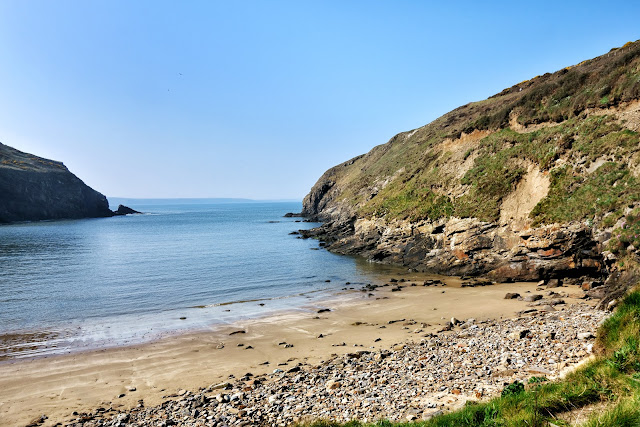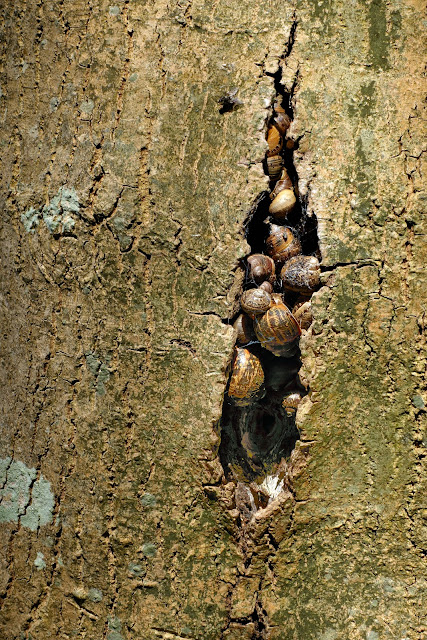Today a trip to Skomer! We boarded the 11am ferry with 15 or so other passengers for our short 10 min crossing, the sea being really calm. On the approach to Skoma we saw Puffin in large numbers flying around, or just swimming in groups on water.
After a short talk by the Wardens, we were off to see what we could see toward the center of the island, photographing the trigpoint on the way and walked toward The Wick.
This was the area that we saw the most puffins in their burrows – brilliant. While strolling along this area we also saw choughs flying around.
We stopped and had our picnic lunch and continued before deciding to head back through the centre toward the old 19th century farm buildings and the landing stage in hope more puffin pictures Saw some on the water only, but great walk anyway.
The boat very crowded on way back but it was only a short journey. All in all, a great trip and well worth doing.
Trig point on Skomer marking its height above sea level at this point of 79.357 m
What would a trip to Skomer be without a picture of a Puffin?
These delightful birds with their brightly coloured bills are part of the largest colony of puffins in Southern Britain. Each year around 6,000 of them return to spend the spring and summer on Skomer.
Puffins arrive on Skomer in late March, but don’t immediately settle down on the island. Initially they collect in rafts at sea, as if to build up their confidence to storm the island. But soon they return to the cliff tops to re-occupy burrows where they will lay a single egg which will hatch in June. After, the birds can be seen flying into the island, with beaks lined with sand eels. By late July the birds depart the island and return to a life at sea. It is then that the brightly coloured bills, for which puffins are so recognisable, fade, to come to life again next spring.
Many people are surprised when they first see a puffin by how small they are, just 30cm from beak to tail. They also marvel at how relaxed they seem around visitors to the island, crossing the paths to reach their burrows, while navigating their way through feet and legs.
The day we arrived, many had gone fishing, but we managed to see several around their burrows.
Our boat returning to the mainland.
Harold`s Stone
The Harold Stone is an erect monolith, 1.7m high by 0.8m by 0.5m. It tapers from a broad base to a point, with its edges aligned nearly north-south; its wide face is orientated to face the sea to the east and the island to the west. It is one of several stones in south-west Wales bearing the same name. Gerald of Wales asserted that the stones were erected by Earl Harold to commemorate his victories over the Welsh in 1063. Although the Harold Stone on Skomer is currently undated, excavations at other similar stones in Pembrokeshire have always yielded a prehistoric, or Bronze Age, date. It is therefore safe to assume that this stone is also a Bronze Age monument, marking a burial (in a cremation urn) or an area of now concealed ritual and funerary activity.
It has be said that not everyone thinks it is that old – but it sounds good!
Lime Kiln on Skomer
Awaiting the boat from the mainland
Once back on the mainland, we moved a short distance to a car park closer to Marloes Sands where a walk revealed another Earthcache.
Marloes Sands is another stunning beach and the Earth Cache well worth seeing. It`s a 1.5 kilometres (0.93 mi) long remote sandy beach where the Earth Cache was situated. Not a soul in sight!
The Three Chimneys
Geologists journey here to this remote spot from all over the world to take a look at an exposed stretch of Silurian rocks known as The Three Chimneys – near-vertical beds of alternating sandstones and siltstones demonstrating different states of weathering. Geological Surveyors have carved in the rock a small arrow, not difficult to find, to mark where the Silurian rock ends and the Old Red Sandstone begins. This picture was proof of my visit to the Earth Cache.
Wild flowers galore this time of year.


















































